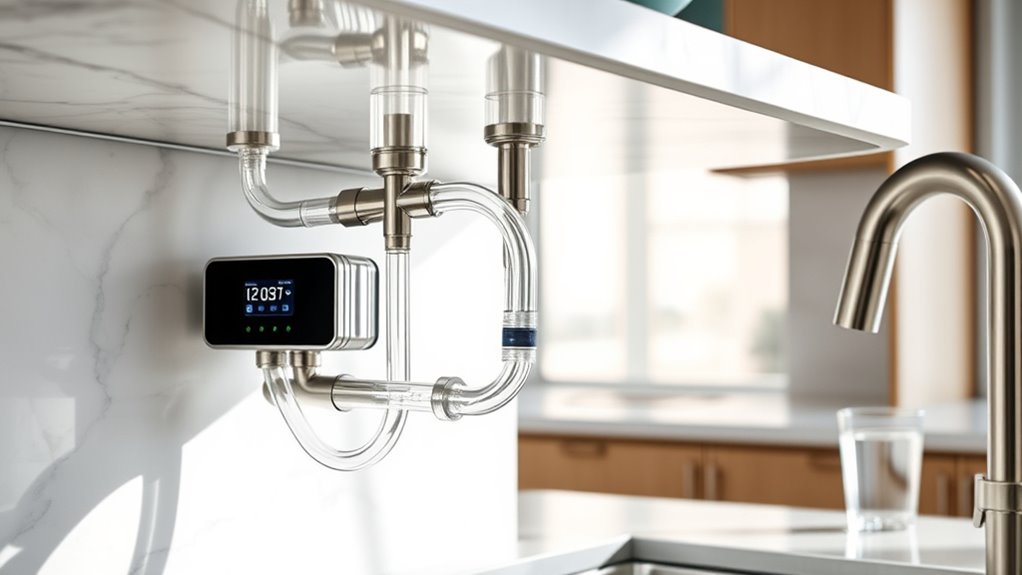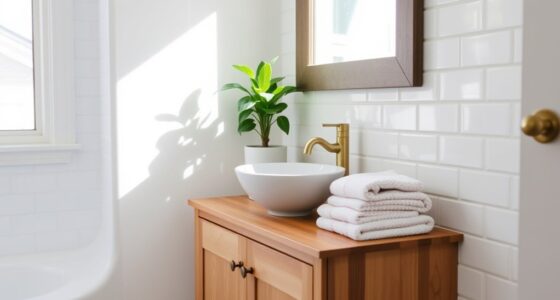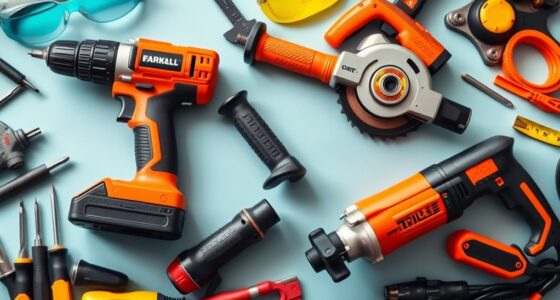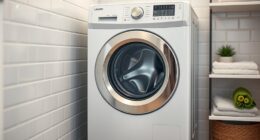To choose a whole house water filtration system, start by testing your water to identify specific contaminants like chlorine, heavy metals, or bacteria. Consider the types of filters—sediment, activated carbon, or UV—that target your needs. Check flow rates, capacity, and certifications to make certain it suits your household demand and meets safety standards. Think about installation, maintenance costs, and your budget. Continue exploring to discover how to select the best system tailored for your home.
Key Takeaways
- Assess your water quality with testing to identify specific contaminants and determine suitable filtration needs.
- Choose a system with appropriate filter types (sediment, carbon, UV) based on your household’s water contaminants.
- Consider capacity, flow rate, and certification to ensure the system meets your household’s water demand and quality standards.
- Evaluate installation requirements, maintenance needs, and compatibility with existing plumbing for long-term convenience.
- Review customer feedback and testing results to ensure the system provides effective, reliable, and cost-efficient filtration.
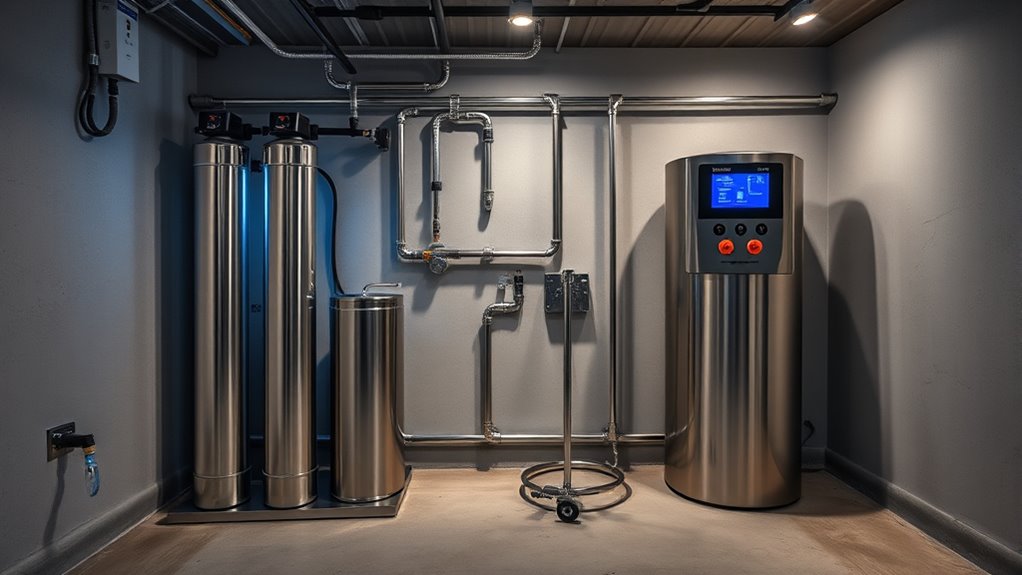
Choosing a whole house water filtration system is a smart way to guarantee clean, safe water for your entire home. When selecting a system, you need to understand the different types of filters available. Sediment filters remove particles like dirt and rust, while activated carbon filters target chemicals, odors, and contaminants such as chlorine. Catalytic carbon filters are especially effective at removing chloramines and other specific pollutants. UV filters use ultraviolet light to neutralize bacteria and viruses, providing an added layer of protection. Many systems combine these filters in multiple stages, maximizing contaminant removal and ensuring thorough water quality. Research indicates that properly selected filtration systems can reduce health risks associated with contaminated water. Cost is an essential factor. Basic systems start around $577, but prices can climb considerably based on complexity and features. You should consider your household’s water usage to choose a system that matches your flow rate needs, which typically range from 5 to 20 gallons per minute (GPM). A system that can handle your household’s demand prevents pressure drops and guarantees everyone has access to clean water. Certifications from organizations like NSF/ANSI are vital indicators of a system’s ability to meet specific contaminant removal standards, giving you confidence in its performance.
Performance and dependability matter too. Look for systems with high capacities—some can filter up to a million gallons before requiring replacement—which reduces maintenance frequency. Testing results showing high chlorine reduction rates, such as 97%, demonstrate effective contaminant removal. Customer reviews provide real-world insights into a system’s reliability and ease of use, helping you avoid models that might be prone to issues. Also, factor in replacement costs; affordable filters that last longer can save you money over time. Additionally, understanding your specific water contaminants through testing can help you select a more targeted filtration system, improving overall safety and effectiveness. Your water quality needs should guide your choice. If you’re on municipal water, you might only need to filter out chlorine and chemicals, but well water could contain heavy metals, iron, manganese, or scale buildup, requiring specialized filters. Conduct a water test to identify the specific contaminants you face, ensuring the selected system addresses those issues. Local water regulations and standards can influence your choice, especially if certain contaminants are prevalent or regulated.
Installation and maintenance are essential considerations. Some systems are DIY-friendly, while others require professional setup. Regular maintenance, including filter replacement, is necessary to keep your system functioning effectively. Make sure the system fits your space and plumbing configuration, and verify compatibility with your existing setup. Budgeting involves initial costs, ongoing filter replacements, and potential support or warranty fees. Long-term savings from reduced bottled water purchases and extended appliance life make investing in a quality system worthwhile. Ultimately, choosing the right whole house water filtration system involves balancing your household’s needs, water quality, budget, and maintenance preferences to guarantee safe, clean water for everyone.
Frequently Asked Questions
How Often Should I Replace the Filter Cartridges?
You should replace your filter cartridges based on the type and water quality. Pre-sediment filters typically last 3–6 months, while post-filters may need changing every 6–12 months. Keep an eye on water pressure, taste, or odor changes, as these signs indicate it’s time for a replacement. Follow your system’s manufacturer guidelines, and consider water testing for more precise replacement timing. Regular maintenance ensures your water stays clean and safe.
Can a Whole House System Remove Specific Contaminants?
Did you know that some reverse osmosis systems can remove over 94% of PFAS, a harmful contaminant? A whole house system can indeed target specific contaminants like chlorine, heavy metals, pesticides, bacteria, and even parasites. By choosing the right filters, you’ll improve water quality, protect your plumbing, and promote better health. Regular maintenance and certifications make sure your system effectively reduces these pollutants, making your home safer and healthier.
What Is the Installation Process Like for a Whole House Filter?
Installing a whole house filter involves turning off your main water supply, draining the system, and then mounting the filter securely on a wall or stable surface. You’ll connect the piping carefully, guaranteeing compatibility with your existing plumbing. After installation, it’s vital to check for leaks, test water flow, and monitor system performance. Taking your time and following the manufacturer’s instructions helps guarantee a smooth, effective setup.
How Much Does a Whole House Water Filtration System Cost?
When considering the cost of a whole house water filtration system, expect to spend between $850 and $5,400, with an average of around $2,273. Factors like system type, home size, and installation complexity influence prices. Basic filters are more affordable, while advanced systems with multiple stages or UV filters cost more. Remember, you’ll also need to budget for filter replacements and possible additional plumbing or electrical work.
Will a Filtration System Affect My Water Pressure?
A filtration system can affect your water pressure, especially if it’s undersized or not properly installed. When water passes through filters, resistance increases, which may reduce flow if the system isn’t matched to your household’s demand. Regular maintenance, like filter changes, helps maintain pressure. Properly sized and professionally installed systems usually keep pressure steady, but neglecting maintenance or choosing the wrong system can lead to noticeable drops in water pressure.
Conclusion
Selecting the right whole house water filtration system is like finding the perfect balance for your home’s harmony. When you pay attention to your water’s subtle nuances and trust your instincts, you create a sanctuary that nurtures your well-being. Remember, the ideal system gently guides your water’s journey, quietly supporting your daily life. In doing so, you craft a haven where purity and comfort blend seamlessly, enriching your home’s quiet, enduring harmony.
